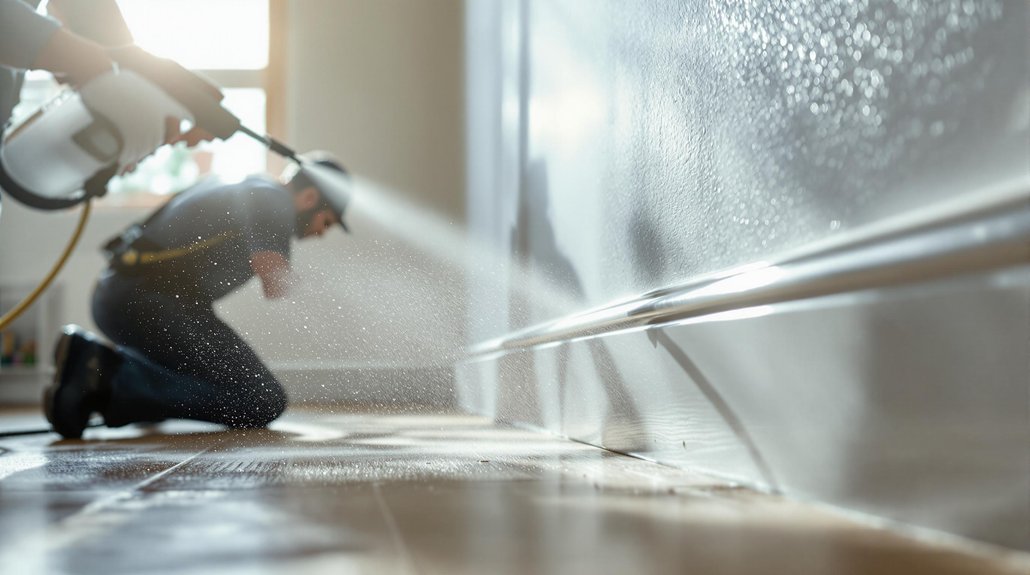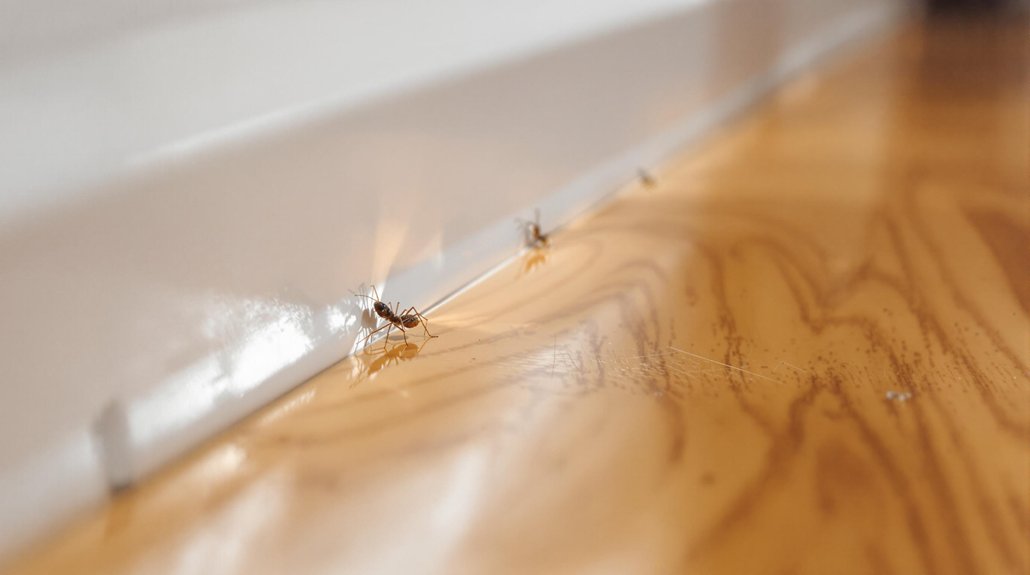Exterminators spray baseboards in San Antonio because these areas are common hiding spots for pests like ants, cockroaches, and mice. Baseboards often have gaps and cracks that serve as entry points for these unwanted guests. Spraying this area allows exterminators to target pests effectively and efficiently. Additionally, keeping baseboards treated can help prevent future infestations. There’s more to learn about the reasons and benefits of these treatments.
Key Article Highlights
- Baseboards provide hidden spaces for pests, making them a primary target for exterminators to eliminate infestations effectively.
- Many common pests, like ants and cockroaches, frequently hide and travel along baseboards, necessitating targeted treatment.
- Easy access to baseboards allows exterminators to apply treatments directly where pests are likely to nest and enter homes.
- Regular treatment of baseboards enhances pest control efficiency, reducing the risk of infestations over time.
- Focusing on baseboards minimizes pesticide use, limiting chemical exposure to non-target areas for safer pest management.
The Role of Baseboards in Pest Behavior
Although baseboards are often overlooked in home design, they play a significant role in pest behavior. These structures provide a hidden space where pests can hide and travel. Many insects seek shelter in the gaps between the wall and the baseboard, making these areas critical to understanding pest habits. Baseboards can also collect dust and debris, attracting pests like ants and cockroaches. Additionally, the materials used in baseboards can influence pest behavior; for instance, wood can be a food source for termites. Integrated pest management is an effective strategy that addresses issues related to baseboards through various treatment methods. Implementing exclusion repairs around baseboards can further reduce pest access and activity. Proper maintenance and inspection of baseboards can help identify potential pest problems early. Consequently, recognizing the baseboard significance is essential for effective pest control strategies in any home. Routine inspections are crucial for detecting pest activity and ensuring the effectiveness of treatments.
Common Pests Found Near Baseboards
Baseboards often serve as a hiding place for various pests that invade homes. Common pests found near baseboards include ants, cockroaches, and spiders. Understanding pest behavior patterns is essential for effective control. Exterminators use pest identification techniques to determine the type of infestation. Additionally, flea and tick control measures target these areas to eliminate potential breeding grounds.
| Pest | Identification Techniques | Behavior Patterns |
|---|---|---|
| Ants | Look for trails and nests | Forage in groups |
| Cockroaches | Check for droppings and shells | Nocturnal, seek dark areas |
| Spiders | Observe webs and egg sacs | Mostly solitary |
| Mice | Listen for noises, look for droppings | Nocturnal, often hide near food |
Accessibility of Baseboards for Exterminators

Exterminators need easy access to baseboards for effective pest control. When baseboards are reachable, technicians can apply treatments directly to the target areas. This accessibility helps to guarantee that pests are eliminated more efficiently.
Easy Reach for Technicians
How easily can exterminators access baseboards during their work? The design of most homes in San Antonio allows for easy access to baseboards. This accessibility is crucial for exterminators as they can quickly reach areas where pests hide. When technicians can move efficiently, they complete their tasks more effectively. Easy access reduces the time spent working, leading to better technician efficiency. Exterminators can spray pesticide along the baseboards without obstacles, ensuring a thorough treatment. This method also allows them to identify potential problem areas quickly. Overall, easy access to baseboards is an essential factor in pest control, making it simpler for technicians to perform their jobs and provide effective services for homeowners.
Effective Treatment Target Area
Access to baseboards plays a significant role in effective pest control. These areas are common hiding spots for pests, making them essential for treatment. When exterminators spray baseboards, they target effective pest behavior, as many insects prefer to stay close to walls. This proximity allows for better access and guarantees a higher chance of contact with the chemicals used. A targeted chemical application on baseboards can disrupt pest movement and nesting. By focusing on these areas, exterminators maximize the effectiveness of their treatments. Additionally, baseboards are often easy to reach, allowing for efficient application without much disruption to the home environment. This strategic approach helps guarantee a successful pest control process.
Importance of Targeted Treatment Areas
Targeted treatment areas are essential for effective pest control in homes. Exterminators focus on specific spots to enhance treatment efficiency and guarantee pests are effectively eliminated. Using targeted strategies allows them to concentrate their efforts where pests are most likely to be found. This method not only saves time but also reduces the amount of pesticide needed.
The importance of targeted treatment areas can be summarized as follows:
- Increased Effectiveness: Focuses on pest hotspots for better results.
- Cost Efficiency: Reduces the need for excessive pesticide use.
- Time-Saving: Streamlines the extermination process.
- Minimized Environmental Impact: Limits chemical exposure to non-target areas. Additionally, targeted treatments often include residual sprays that help maintain pest control between visits.
Baseboards as Entry Points for Pests

Baseboards can serve as common pathways for pests to enter homes. Understanding how pests access these areas can help in creating effective prevention strategies. Additionally, the effectiveness of chemical residues used near baseboards plays a key role in pest control efforts.
Common Pest Pathways
While many homeowners focus on sealing cracks and gaps in walls, they often overlook baseboards as potential entry points for pests. These areas can serve as common pathways for pest movement, allowing various insects and rodents to invade homes. Understanding these entry routes is essential for effective pest management.
Key pathways include:
- Gaps in Baseboards: Small openings can easily be overlooked.
- Damaged or Loose Baseboards: These can create spaces for pests to enter.
- Moisture Accumulation: Wet areas near baseboards attract pests.
- Poorly Sealed Floors: Gaps between the floor and the baseboard can be inviting.
Chemical Residue Effectiveness
Pest control methods often include the application of chemical residues, which can be particularly effective in areas like baseboards. Baseboards serve as common entry points for pests, making them prime targets for treatment. Chemical efficacy is vital, as it determines how well a pesticide works against various pests. Additionally, residue longevity is important, as longer-lasting chemicals provide ongoing protection.
| Chemical Type | Efficacy Duration |
|---|---|
| Pyrethroids | 30 days |
| Insect Growth Regulators | 60 days |
| Neonicotinoids | 90 days |
| Borates | 120 days |
Understanding these factors helps exterminators choose the right treatments for lasting pest control.
Preventative Maintenance Strategy
To maintain a pest-free environment, homeowners should consider a preventative maintenance strategy that focuses on baseboards, which often act as entry points for various insects. Implementing a routine cleaning schedule and conducting preventative inspections can greatly reduce pest invasions.
Homeowners can follow these steps:
- Regularly clean baseboards to remove dust and debris that attract pests.
- Inspect for gaps or cracks where insects may enter, ensuring these are sealed.
- Apply pest deterrents around baseboards as a preventive measure.
- Schedule professional inspections at least twice a year to identify potential issues early.
Prevention of Pest Infestations
Effective prevention of pest infestations requires vigilance and regular maintenance. Understanding pest behavior is vital in this effort. Homeowners should routinely inspect their properties for signs of pests, such as droppings or nests. Keeping living spaces clean and clutter-free can deter pests from entering. Sealing cracks and gaps in walls, windows, and doors can also help block entry points. Additionally, proper waste management, including sealed trash cans, further aids infestation prevention. Regularly checking for standing water is essential, as moisture attracts pests. It is important to educate oneself about the specific pests common in the area, as this knowledge can inform better prevention strategies. Furthermore, implementing liquid soil treatments can effectively prevent and eliminate subterranean termite colonies. Overall, proactive measures lead to a healthier living environment free from pest infestations.
Long-Term Benefits of Baseboard Treatments
While maintaining a pest-free home is a priority for many homeowners, baseboard treatments offer long-term benefits that extend beyond immediate pest control. These treatments provide:
- Long-term protection against various pests, reducing the risk of infestations.
- Cost savings by potentially lowering the need for frequent treatments.
- Enhanced home value, as a pest-free environment attracts buyers.
- Sustainable practices that minimize harmful chemicals, creating a safer living space.
Homeowner Maintenance Tips for Pest Control
Homeowners can further enhance the long-term benefits of baseboard treatments by implementing regular maintenance tips for pest control. Simple actions can greatly reduce pest problems and create a more comfortable living environment.
| Homeowner Tips | Description |
|---|---|
| Seal Cracks and Gaps | Check for and seal any openings. |
| Keep Areas Clean | Regularly clean kitchens and floors. |
| Remove Standing Water | Eliminate excess moisture sources. |
Frequently Asked Questions
How Often Should I Have My Baseboards Treated for Pests?
How often should one treat baseboards for pests? Frequency recommendations suggest every three to six months, depending on treatment intervals and pest activity. Consistency in maintenance helps guarantee a pest-free environment in the home.
Can I Clean My Baseboards After Treatment?
After treatment, it is advisable to avoid baseboard cleaning for a specified time. This allows the pesticide to remain effective. Following post-treatment precautions guarantees ideal results and keeps the home pest-free for longer periods.
Are There Any Health Risks Associated With Baseboard Spraying?
Imagine a gardener tending to delicate plants, mindful of chemical exposure. Similarly, health concerns arise with baseboard spraying. Proper precautions can minimize risks, ensuring a safe environment while effectively addressing pest issues in homes.
What Types of Chemicals Are Used in Baseboard Treatments?
Various chemicals are used in baseboard treatments, focusing on chemical effectiveness and treatment safety. Common options include insecticides that target pests while minimizing risks to humans and pets, ensuring a balance between efficacy and safety.
How Long Does the Pest Treatment Effect Last?
The duration of pest treatment effectiveness varies. Typically, it lasts until the next treatment, which depends on the pest lifecycle. Regular treatment frequency is essential to manage infestations and guarantee long-term pest control success.
Call today if you are in need of a pest exterminator in San Antonio, TX
(210) 796-6593

